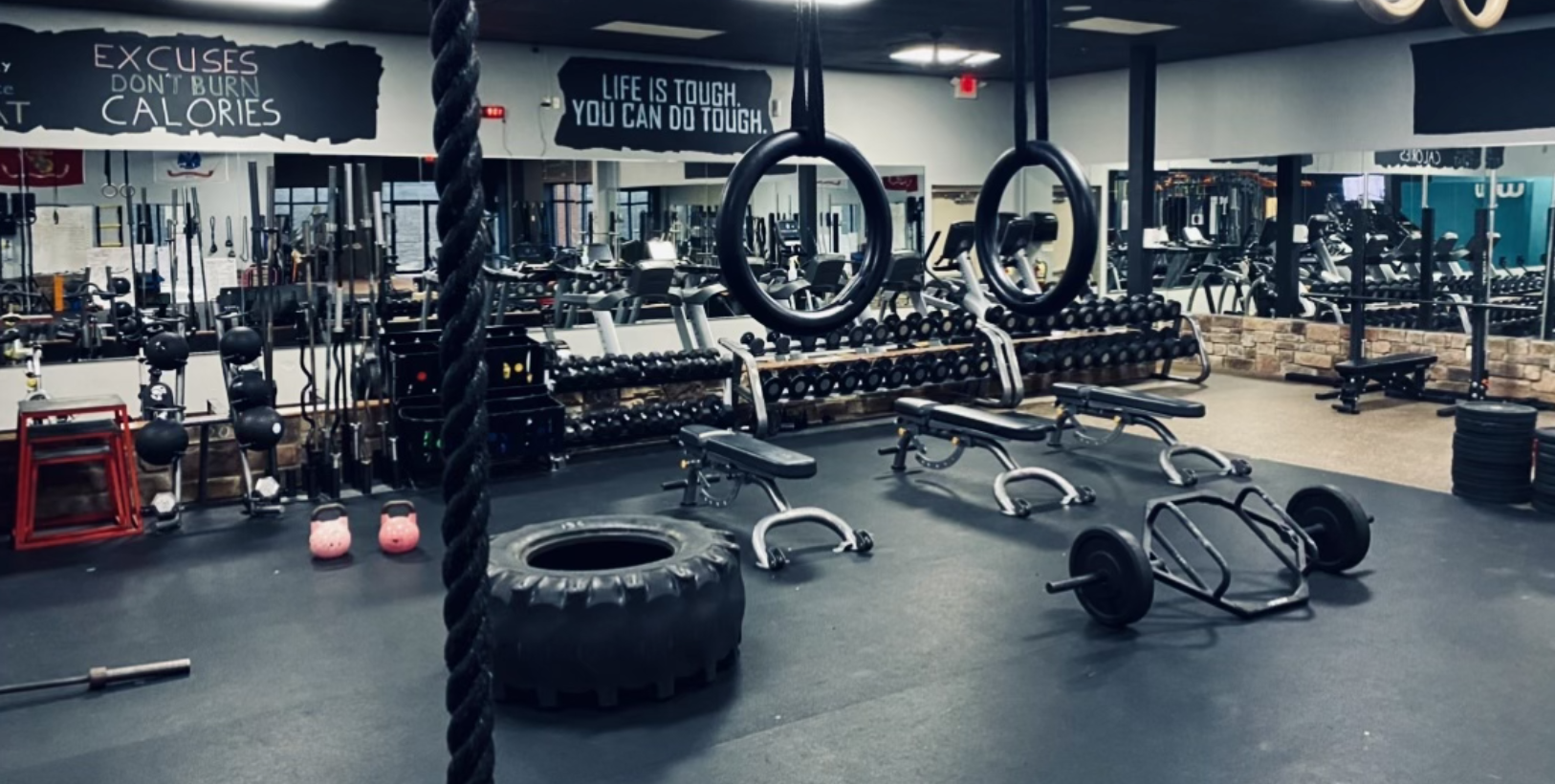How To Read Programs
Terminology
Exercise Selection – A movement for the body to perform.
Example – Bench Press
Rep – Stands for repetition. This is how many times you do a single exercise in a row without stopping.
Example – Bench Press 12.
Set – A set refers to a group of repetitions done without stopping.
Example – Bench Press 4×12. The first number is the number of sets the second number is the number of reps.
Tempo – The speed at which an exercise is performed, up or down, pausing, up or down. Here’s the tricky thing, different exercises you will start going up against gravity or down with gravity. The numbers are always in seconds.
See the very bottom of the page for an in-depth explanation of tempo.
Example – Bench Press 4×12 Tempo – 2/1/2
Rest – Time to rest in between each set before beginning a set again.
Example – Bench Press 4×12 Tempo – 2/1/2 - rest – 1 minute 45 sec
One Rep Max Percentage / 1RM – The percentage that you multiply by your one-rep max in order to find a sufficiently challenging weight to train with in order to enlist a muscular adaptation.
Example – Bench Press 4×12 – Tempo 2/1/2 – rest 1 minute 45 sec – 1RM 75%
RPE – Rate of Physical Exertion, your perceived effort level. RPE is another way to gauge your physical exertion levels similar to one rep max percentages. I prefer to use both. RPE is more based on “feel” which can be helpful when you are in the fourth week (just an example) of your program. You are using the same or very similar one-rep max percentage and the week prior you did twelve reps but this week you can barely get ten with the same weight. This will help us as coaches recognize when you need a de-load week to let your central nervous system fully recover so you may continue to progress. Numbers are great, they never lie but they can be too rigid with performance standards. The human body is not a computer system. It’s half computer science (physiological) and half animal (psychological).
Example – Bench Press 4×12 – Tempo 2/1/2 – Rest 45 sec – 1RM 75% – RPE 8
RPE In-depth
6-8 is the RPE zone I recommend for the best results. The lower and higher RPE still have value, lower RPE is great to learn proper form, warming up, or practice power/explosiveness in a lift. The Higher RPE 9-10 should be trained after you learn proper form and learn to bail out of a lift/exercise safely so you don’t destroy your joints if an accident occurs.
10 – Max-out, your 1 rep max. You can only get 1 rep, extremely hard to lift. If you keep doing sets or increase the weight your form will break down risking injury.
9 – You can get 1 maybe 1.5 reps but it’s extremely hard. Form is on the edge of breaking down. RPE 9-10 is generally reserved for more advanced lifters who know their body well, know how to bail out of an exercise safely, and know when to stop when they feel from breaking down.
8 – You can get 1-2 more reps. Very challenging on the last 1-2 reps of your set. You’re pushing it, but not enough for the form to break down. You’re stopping 1-2 reps shy of RPE 9.
7 – You can get 2-3 more reps until it this turns into an RPE 8. This is still a very challenging set.
6 – This weight feels good to move around. This is a good RPE to work on higher rep sets in the 12-20 reps. You can get at least 3-4 more reps until turning into an RPE 7.
5 – Semi-challenging warm-up weight. You can get at least 4-5 more reps before turning into an RPE 6. You can move around the weight easily. This is a good RPE to work on higher rep sets in the 12-20 reps.
4 – Warmup weight / Easy peasy. On the edge of Rehab’s weight.
3 – Warmup weight / Rehab weight.
2 – Warmup weight / Rehab weight.
1 – Warmup weight / Rehab weight.
Programming Vocabulary
Program – a fitness plan in which you train specific body parts a certain way for a time period to enlist a specific adaptation of the body.
Programming – creating an adaptive fitness plan adjusting to your body’s responses to reach your goals.
Weekly Split – A rotation of specific body parts you focus on during the week on certain days to optimize the 48h-72h recovery window.
Form – How an exercise is performed correctly and safely to ensure proper joint function leading to improvement of the body, not injury.
ROM – Range of motion - referring to an exercise.
Min – minute, unit of time
Sec – a second, unit of time
Hand Grip - Pronation, Supination, Neutral - learn different hand positions to work different parts of your upper body muscularity.
Drop Set – Drop sets are when you perform an exercise and then drop (reduce) the weight and continue for more reps without rest.
Example – Bench Press 4×12 Tempo - 1/0/3 drop set 4×5 Tempo – 2/1/2 Rest – 45 sec
Superset – Doing two or more exercises back to back with no rest.
Example – Bench Press 4×12 superset Dumbell Bicep Curl 4×8 Tempo – 2/1/2 Rest – 45 sec
Pyramid set – Doing sets of upward scaling of weight or going back down in weight like a pyramid.
Example – Bench Press 4×5 Pyramid Set up to 3×2 RPE 9
Since 3×2 is a high RPE you use a pyramid set to slowly increase the weight safely while warming up at the same time.
Let’s say I start with 1×5 at 95lb then 1×5 at 135lb then 1×5 at 155lb then 1×5 at 185lb.
I then start my set of 3×2 at 205lb at RPE 9.
I did 4×5 reps in a pyramid set, transitioning into my higher weighted and RPE sets of 3×2 RPE 9.
Failure – When you physically cannot do one more rep. You’ll hit a pain threshold where the mind will be screaming for you to stop but if you keep pushing your muscle will literally fail to perform one more rep. Then you’re at muscular failure
Example – Bench Press 4x12+Failure Tempo 3/1/3 – Rest 2min – RPE 10.
In this set use a weight that you can get at least 12 reps with then we keep pushing into musculature failure.
Pump – Getting a pump is one of the best feelings you can ever get. A pump is hard to imagine if you have never had one. Usually, if your train hard enough you will get one in whatever muscle you’re working, so imagine your bicep warm, hard, and half an inch bigger than normal because of all the blood rushing to your muscle along with an adrenaline rush. That’s what a pump feels like. It’s similar to a Runner’s High. The “Pump” will become addicting if you let it. That’s the goal. Fitness should be a healthy self-improvement addiction that you develop over time.
Eccentric – The motion of an active muscle while it is lengthening.
For example – you do a standing bicep curl, starting from at the shoulder your hands are traveling down towards your hip.
Concentric – The motion of an active muscle while it is shortening.
For example – you do a standing bicep curl, and your hands are traveling upward from your hip up to your shoulder.
Isometric – The joint angle and muscle length do not change during contraction. Zero range of motion.
Example – Holding a Plank position or holding your hand at the top of a bicep curl near your shoulder.
Tempo in-depth – C/I/E
To see a video explaining tempo please click - HERE
Concentric / Isometric / Eccentric
C/I/E = x/x/x
Concentric – The motion of an active muscle while it is shortening.
For example – you do a standing bicep curl, and your hands are traveling upward from your hip up to your shoulder.
1/x/x = C/x/x - Concentric
Isometric – The joint angle and muscle length do not change during contraction. Zero range of motion.
Example – Holding a Plank position or holding your hand at the top of a bicep curl near your shoulder.
Isometric is very easy to understand. It’s the point where you transfer from Concentric into Eccentric or Eccentric into Concentric.
x/1/x = x/I/x - Isometric
Eccentric – The motion of an active muscle while it is lengthening.
For example – you do a standing bicep curl, starting from at the shoulder your hands are traveling down towards your hip.
x/x/1 = x/x/E - Eccentric
You will normally see Tempo written like this - Bicep Curl 4×12 - 2/1/2 - 3 minute rest
A tempo of 2/1/2 would be
2 seconds - Concentric
1 second - Isometric
2 seconds - Essentric
Squat – although our first number is concentric in tempo programming the squat first starts with eccentric movement.
Keep in mind, as opposed to the bicep curl where it first started with concentric movement and finishes with eccentric movement.
Squat - 3×8 - 1/2/3
A squat would be performed as – 3/2/1
The squat starts at the last number being… Eccentric, Isometric, Concentric. This is because the squat first starts with eccentric movement where the muscle lengthens.
Although program writing will always be in Concentric, Isometric, and Eccentric, order. Depending on the exercise you may need to reverse the order or keep it the same.
Bicep Curl – 1×8 – Tempo 1/2/3
Perform as – 1/2/3
vs
Squat – 1×8 – Tempo 1/2/3
A squat would be performed as – 3/2/1
Reps In Reserves - RIR
RIR = Reps in Reserve. RIR 4-3 means you should only be able to get 4-3 more reps with the weight used. Week 1 - 3x12 - RIR 4-3. If I use 120lb and I feel like I could have done more than 4 reps at the end of my set of 12 then I need to go heavier. If I use 155 and I feel I can only get 4-3 more reps at the end of my 12 reps then that is the right weight.
RIR is generally for accessories only. Scale this for weeks ramping up. Use RIR to select the weight. Each week follow the below.
RIR Example - Cable Machine Lat Pull Downs
Week 1 - 3x12 - RIR 4-3 - 155lb
Week 2 - 3x12 - RIR 3-2 - 160lb
Week 3 - 3x12 - RIR 2-1 - 165lb
Week 4 - 3x12 - RIR Failure - 170lb
Week 1 - RIR 4-3
Week 2 - RIR 3-2
Week 3 - RIR 2-1
Week 4 - RIR Failure
Week 5 - De-load

